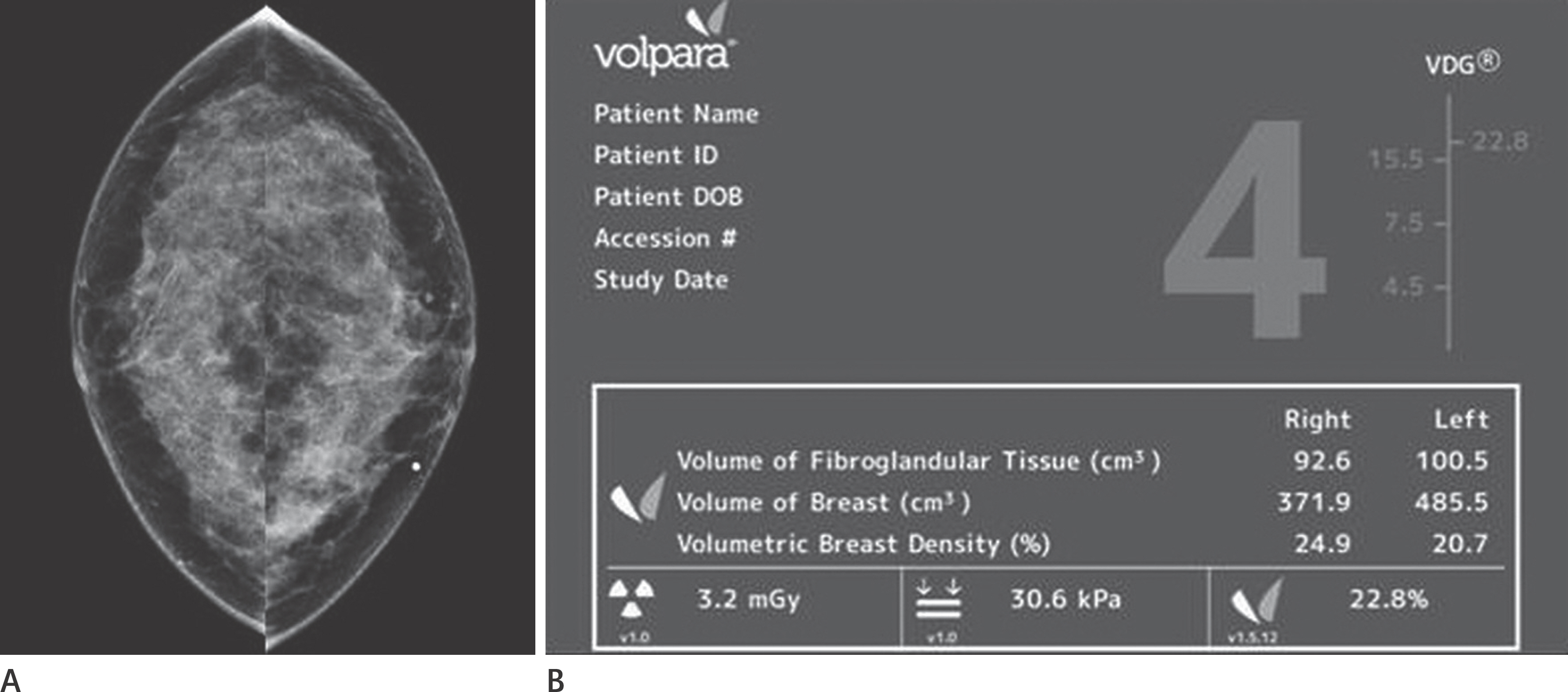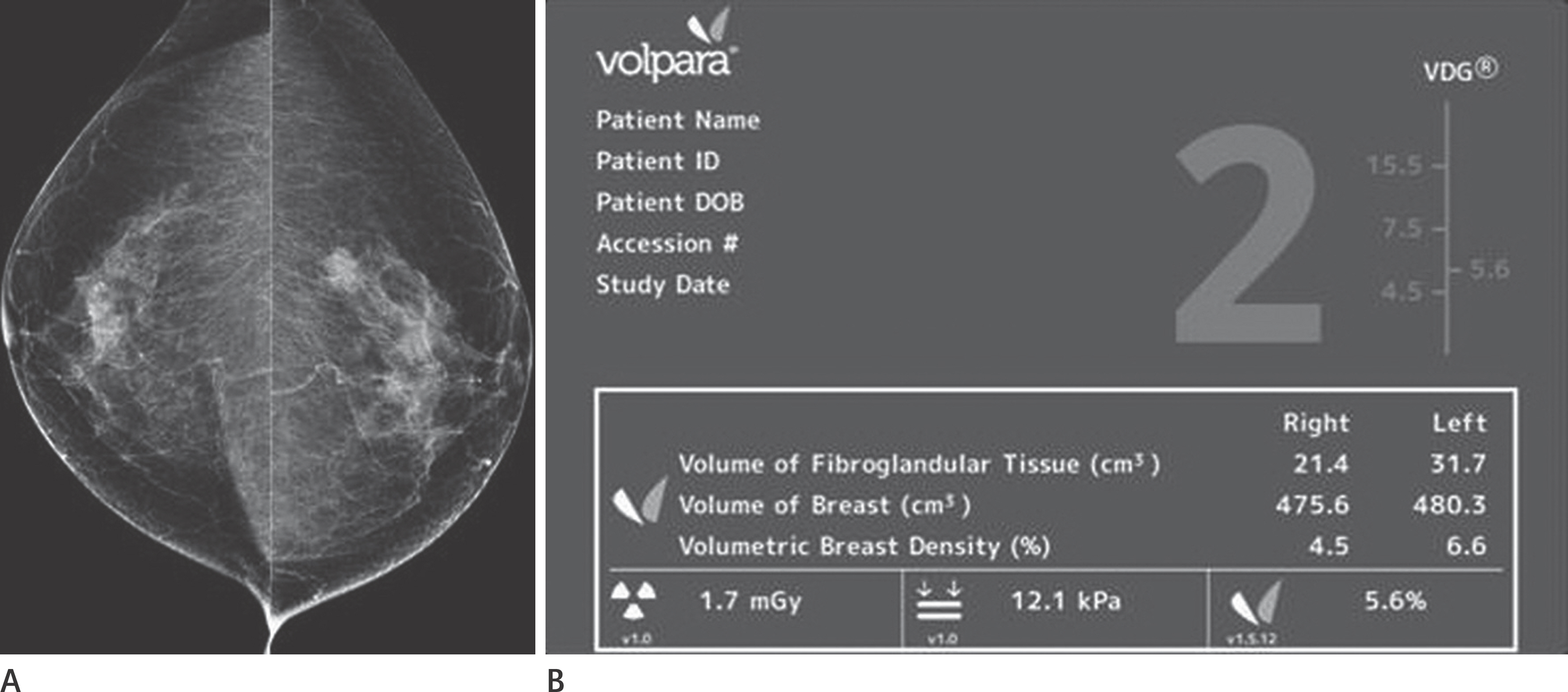J Korean Soc Radiol.
2018 Jul;79(1):18-26. 10.3348/jksr.2018.79.1.18.
Association of Volumetric Breast Density with Clinical and Histopathological Factors in 205 Breast Cancer Patients
- Affiliations
-
- 1Department of Radiology, School of Medicine, Kyungpook National University, Kyungpook National University Chilgok Hospital, Daegu, Korea. greenoaktree9@gmail.com
- KMID: 2416401
- DOI: http://doi.org/10.3348/jksr.2018.79.1.18
Abstract
- PURPOSE
To evaluate the association of volumetric breast density with clinicopathological factors in breast cancer patients.
MATERIALS AND METHODS
A total of 205 Korean patients with breast cancer who underwent mammography for initial staging between January 2015 and June 2016 were enrolled. Volumetric breast density was measured using a fully automated commercial method (Volpara®). in the contralateral breast. The association of volumetric breast density with clinical and histopathological factors was evaluated using t-test and analysis of variance as appropriate.
RESULTS
Mean volumetric breast density in all patients was 13.5% (range, 4.1-34.9%). The mean volumetric breast density in patients with symptom-detected cancers was significantly higher than that in those with screening-detected cancers (14.9% vs. 11.8%, p = 0.002). Mean volumetric breast density tended to decrease with age (20-39 years: 19.0%, 40-59 years: 14.3%, 60-80 years: 7.7%). The mean volumetric breast density in postmenopausal women was significantly lower than that in premenopausal women (9.8% vs. 17.6%, p < .001). Other histopathological factors including histologic grade or hormone receptor status were not associated with volumetric breast density.
CONCLUSION
Our results suggest that volumetric breast density is associated with the method of detection, age, and menopausal status.
Figure
Reference
-
1.Boyd NF., Guo H., Martin LJ., Sun L., Stone J., Fishell E, et al. Mammographic density and the risk and detection of breast cancer. N Engl J Med. 2007. 356:227–236.
Article2.McCormack VA., dos Santos Silva I. Breast density and parenchymal patterns as markers of breast cancer risk: a meta-analysis. Cancer Epidemiol Biomarkers Prev. 2006. 15:1159–1169.
Article3.Harvey JA., Bovbjerg VE. Quantitative assessment of mammographic breast density: relationship with breast cancer risk. Radiology. 2004. 230:29–41.
Article4.Harvey JA., Holm MK., Ranganath R., Guse PA., Trott EA., Hel-zner E. The effects of bazedoxifene on mammographic breast density in postmenopausal women with osteoporosis. Meno-pause. 2009. 16:1193–1196.
Article5.Cuzick J., Warwick J., Pinney E., Duffy SW., Cawthorn S., Howell A, et al. Tamoxifen-induced reduction in mammographic density and breast cancer risk reduction: a nested case-control study. J Natl Cancer Inst. 2011. 103:744–752.
Article6.Harvey JA., Bovbjerg VE., Smolkin ME., Williams MB., Petroni GR. Evaluating hormone therapy-associated increases in breast density comparison between reported and simultaneous assignment of BI-RADS categories, visual assessment, and quantitative analysis. Acad Radiol. 2005. 12:853–862.7.Kolb TM., Lichy J., Newhouse JH. Comparison of the performance of screening mammography, physical examination, and breast US and evaluation of factors that influence them: an analysis of 27,825 patient evaluations. Radiology. 2002. 225:165–175.
Article8.Pinsky RW., Helvie MA. Mammographic breast density: effect on imaging and breast cancer risk. J Natl Compr Canc Netw. 2010. 8:1157–1164. quiz 1165.
Article9.American College of Radiology. Breast Imaging Reporting and Data System (BI-RADS). 4th ed.Reston, VA: American College of Radiology;2003.10.Byng JW., Yaffe MJ., Jong RA., Shumak RS., Lockwood GA., Tritchler DL, et al. Analysis of mammographic density and breast cancer risk from digitized mammograms. Radio-graphics. 1998. 18:1587–1598.
Article11.Zhou C., Chan HP., Petrick N., Helvie MA., Goodsitt MM., Sahin-er B, et al. Computerized image analysis: estimation of breast density on mammograms. Med Phys. 2001. 28:1056–1069.
Article12.Chang YH., Wang XH., Hardesty LA., Chang TS., Poller WR., Good WF, et al. Computerized assessment of tissue composition on digitized mammograms. Acad Radiol. 2002. 9:899–905.
Article13.Ng KH., Lau S. Vision 20/20: mammographic breast density and its clinical applications. Med Phys. 2015. 42:7059–7077.
Article14.Destounis S., Johnston L., Highnam R., Arieno A., Morgan R., Chan A. Using volumetric breast density to quantify the potential masking risk of mammographic density. AJR Am J Roentgenol. 2017. 208:222–227.
Article15.Leong SP., Shen ZZ., Liu TJ., Agarwal G., Tajima T., Paik NS, et al. Is breast cancer the same disease in Asian and Western countries? World J Surg. 2010. 34:2308–2324.
Article16.Boyd N., Martin L., Stone J., Little L., Minkin S., Yaffe M. A lon-gitudinal study of the effects of menopause on mammographic features. Cancer Epidemiol Biomarkers Prev. 2002. 11:1048–1053.17.Choppin SB., Wheat JS., Gee M., Goyal A. The accuracy of breast volume measurement methods: a systematic review. Breast. 2016. 28:121–129.
Article18.Kovacs L., Eder M., Hollweck R., Zimmermann A., Settles M., Schneider A, et al. Comparison between breast volume measurement using 3D surface imaging and classical techniques. Breast. 2007. 16:137–145.
Article19.Veitch D., Burford K., Dench P., Dean N., Griffin P. Measurement of breast volume using body scan technology (computer-aided anthropometry). Work. 2012. 41(Suppl 1):4038–4045.
Article20.Teo I., Whelehan P., Macaskill JE., Vinnicombe S., Munnoch DA., Evans A. VolparaTM as a measurement tool for breast volume. J Plast Reconstr Aesthet Surg. 2016. 69:581–582.
- Full Text Links
- Actions
-
Cited
- CITED
-
- Close
- Share
- Similar articles
-
- Mammography with a fully automated breast volumetric software as a novel method for estimating the preoperative breast volume prior to mastectomy
- The Highligts of 28th Annual Meeting of San Antonio Breast Cancer Symposium
- Surgery of Breast Cancer during the Last 5 Years: More Sophisticated and Specialized?
- Impact of Awareness of Breast Density on Perceived Risk, Worry, and Intentions for Future Breast Cancer Screening among Korean Women
- Mammographic Breast Density Evaluation in Korean Women Using Fully Automated Volumetric Assessment



